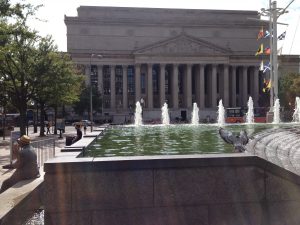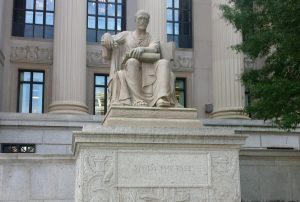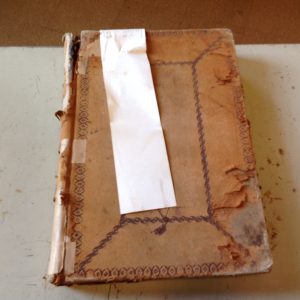
National Archives Building
Many of my stories will involve information discovered at the National Archives, so I thought it would be good to explain.
The National Archives and Records Administration, called “NARA”, is the agency responsible for preserving government and historical records. NARA has a network of facilities around the country, but the “Mother Ship” is located in Washington, DC and since we wanted to work with original military records from the Civil War this was the place. NARA can be very intimidating for first time researchers. The building in Washington is huge – occupying two whole blocks between Pennsylvania and Constitution Avenues and bordered on either side by 7th and 9th Streets (leaving no room for an 8th Street). The researcher’s entrance is on Pennsylvania and we had been warned the process to register as first time researchers can take more than an hour if a crowd of first timers were to beat us through the door, so we were waiting at the entrance before the 9:00 opening.
After entering, a researcher sends any bags through an X-ray machine, empties their pockets and passes through a metal detector, and then signs in with armed guards who issue a numbered Visitor’s Badge that must be worn at all times while in the building. Once past this level of security the first time researcher takes an online orientation lesson to learn the dos and don’ts of NARA and how to request information. After passing all the tests Linda and I had our pictures taken and were issued Identification Cards with our own unique ID numbers.

Study The Past
Researchers are allowed to bring cameras, laptop computers and smartphones for research purposes, but notebooks, briefcases, purses and jackets have to be left in coin operated lockers provided by NARA. As I left the locker room one of the guards noticed my cell phone holster and shook her head – not allowed. Pens are not allowed either and everything, even laptop computers, will be inspected to make certain forbidden articles are not smuggled in and rare documents are not smuggled out. This is understandable; we would be touching irreplaceable original documents, many being hundreds of years old and must be protected from thieves … and doodlers.
The staff at NARA is very knowledgeable and will help researchers fill in forms or suggest places to better search for information. Requests for documents are made on NARA forms and completed with NARA pencils, using your name and ID card number. These requests are then submitted to the appropriate first floor archivist at10:00, 11:00, 1:00, 2:00 or 3:00 o’clock and the results of any requests are available for inspection an hour later in the second floor reading room. Downstairs a researcher may request up to four documents at a time, but upstairs is only allowed to check out one at a time to avoid contaminating one set of documents with another. Each document is signed out by date and time and must be signed back in before the next document is released.
 All documents must remain in the reading room and may only be photocopied by NARA employees – and those copies are printed onto easily identifiable blue paper. I was allowed take pictures of documents, but I was warned not use a flash.
All documents must remain in the reading room and may only be photocopied by NARA employees – and those copies are printed onto easily identifiable blue paper. I was allowed take pictures of documents, but I was warned not use a flash.
Document security is very tight and when leaving the reading room everything is again inspected, and any blue paper copies made by NARA employees are secured in a specially constructed green document bag that is sealed on the second floor and then unsealed by guards at the first floor researcher’s exit. You must sign out with the guard and return your numbered name badge before leaving the building.
It is all quite a process, but Linda and I found the results to be spectacular!

 I don’t want to just find my ancestors; I want to discover their life stories and maybe unwind a few family mysteries along the way. Ancestry.com is great for identifying those long dead relatives, but sometimes the best information is not on line at all, sometimes you have to go looking for an original document in a courthouse or church. I love that kind of search, where my reward is finding a document that has been untouched for over a hundred years.
I don’t want to just find my ancestors; I want to discover their life stories and maybe unwind a few family mysteries along the way. Ancestry.com is great for identifying those long dead relatives, but sometimes the best information is not on line at all, sometimes you have to go looking for an original document in a courthouse or church. I love that kind of search, where my reward is finding a document that has been untouched for over a hundred years.
Recent Comments